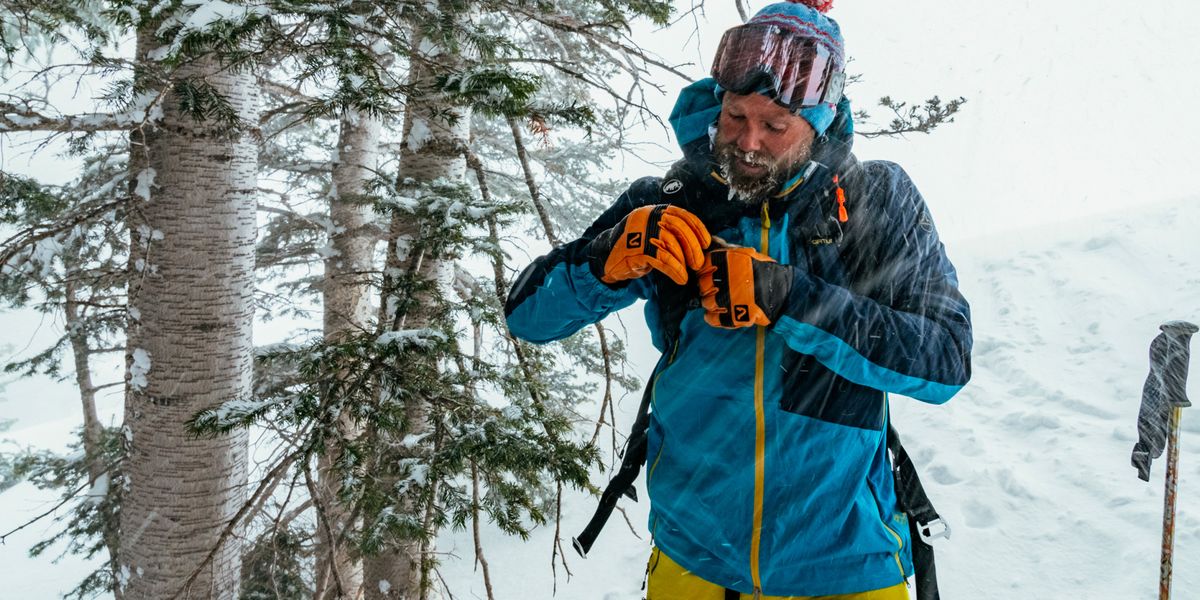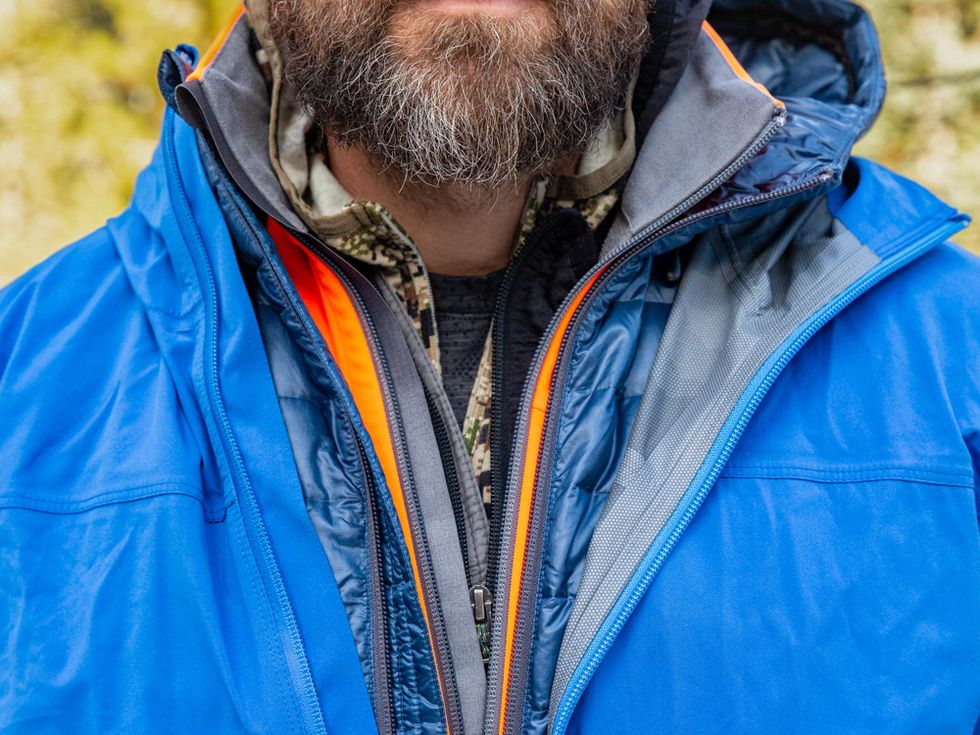
Many people acquire their outdoor apparel one piece at a time. A ski shell here, a puffy jacket there. Base layers received as Christmas gifts. A fleece owned since high school. Then when it’s time to head outside they assemble it all together as best they can. This method often works, but for peace of mind there is a tried-and-true system for layering for outdoor activities in the cold that you can apply whether you’re climbing a 14,000-foot peak or hunting for deer in your backyard.
The simple layering system outlined here will not only keep you warm and dry in any weather, but also save you from buying redundant, expensive items. Below, I explain the purpose of each layer so you can adjust your system for different activities and various weather conditions.
To help sort out the finer details, I interviewed John Barklow, Big Game Product Manager at SITKA, a hunting gear company based in Bozeman, Mont. He is a former Navy S.E.A.L. who helped the United States military modernize its cold weather apparel for the war in Afghanistan. During our exchange, he shared information on his eight-piece layering system, which he summed, “is built from the base layer out to manage moisture, manage body heat, and protect the wearer from the elements.”
Best Outdoor Layers
- Best Base Layer Top Overall: Ibex Woolies Pro Tech Crew
- Best Base Layer Top for Skiing and Snowboarding: Kuhl Akkomplice Crew Long Sleeve
- Best Base Layer Bottoms for Hiking: Outdoor Research Alpinie Onset Bottoms
- Best Base Layer Bottoms for Skiing and Snowboarding: Ortovox 185 Rock ‘N’ Wool Short Pants
- Best Softshell Ski Pants: La Sportiva Ikarus Pants
The Expert: I’m a lifelong skier, hunter, and backpacker based in Breckenridge, Colo. I inherited a penchant for owning more jackets that I can realistically wear from my father. Through my work as a gear writer, I’ve tested well over 100 different jackets, pants, softshells, and base layers during the past decade and learned from athletes and product experts about the science and practice of proper layering. I tend to use the same next-to-skin layers (I love the Ibex Woolies Pro Tech) year-round but swap in season- and sport-specific layers to customize my system to the activity at-hand.
What to Consider in a Layering System
It’s not about keeping warm—and that’s where lots of folks go wrong. They shop for outdoor apparel driven by their fear of not wanting to be cold and then buy layers that are overly insulated or they wear too many layers in total. Ironically, that’s how people end up cold despite their intentions. They sweat out their layers, and nothing makes you colder than damp layers in cold temps. The right layers keep precipitation out, let sweat moisture escape, and keep you just warm enough.
Everything You Need to Know About: Hiking • Surfing • Sailing • Sky Diving
Originally, Barklow created a system with 22 distinct pieces of apparel across eight layers, but narrowed it to eight pieces over the past few decades thanks to his civilian experiences hunting and backcountry skiing, as well as improvements in apparel tech that have led to more versatile layers.
The eight-layer system here is functionally the same as Barklow’s, but you may see other formulations out there which can be helpful to consider. Many brands and experts talk about a three-part system—base, middle, and outer layers for both upper and lower body for a total of six pieces. The difference boils down to whether you use dedicated rain layers or not. The concept of these two systems is basically the same no matter how you build it out.
Next-to-Skin Base Top Layer
This is the foundation of any decent layering system and in warmer weather it might be your only layer. This layer isn’t meant to provide warmth; just quickly transport sweat moisture away from your body.
Merino base layers have natural antimicrobial properties that reduce the telltale stink that builds up on synthetics over time. Synthetics can have a slight advantage for high-output activities as they’re generally lighter and transfer moisture a bit better than merino. Synthetics last forever but unfortunately so does their persistent odor. Merino/synthetic blends such as Nuyarn seem to have captured the best characteristics of both materials.
Next-to-Skin Base Layer Bottom
Base layer bottoms serve the same purpose as base layer tops: to move moisture away from your body. The biggest difference is that unlike base layer tops, bottoms are more likely to be employed to add a measure of warmth as well.
In warmer temps, your next-to-skin bottom layer is often only your underwear, and for those, I highly recommend thin, close-fitting synthetics, though Ibex and Sitka both make interesting merino boxer options. In colder temps, I switch to a slightly heavier base layer bottom when needed.
Softshell Pants
In most situations, this is your outermost bottom layer. Alpine skiers might choose heavy-duty three-layer Gore-Tex piece with insulation, while cyclists, hikers, and early-season hunters often wear a minimalist wind-blocking pant or even just base layer leggings.
I often wear a lighter pant and carry a standalone rain pants layer, but for many activities you can employ a three-layer shell pant that combines the softshell and rain pant layers into one. (Because breathable waterproof membranes are essential and ubiquitous in ski pants, few skiers need any kind of dedicated rain layer.)
Active Insulation
When you think of an insulation layer, it’s natural to picture a cozy down puffy or thick fleece, but instead this layer should provide warming insulation while still remaining breathable. Traditionally, active insulation has been a simple synthetic fleece or softshell, but newer fabrics are being combined into active insulation layers that provide better warmth to weight ratios and weatherproofing with superior breathability.
Light synthetic down layers such as Patagonia’s Nano Air are also an option since they don’t get wet like waterfowl down and still deliver effective warmth if they do get damp. The best active insulation layers usually have a DWR coating for a basic level of water resistance so they can be worn as an outer layer or used as a warming mid-layer under rain or wind shells.
Wind-Blocking Shell
Commonly called a “windbreaker” or a “shell,” this layer includes thin jackets that do little more than cut the chill of the wind. These layers shouldn’t have insulation, and their key feature is keeping the weather off your core while maintaining breathability.
This is mostly a terminal layer, meaning you don’t layer on top of it with insulation or another wind-blocking type layer, as that can severely hamper moisture escape. The one exception is when you’re standing still for a longer period and want to wear a static insulation layer such as a puffy on top to stay warm until you start moving again.
The line between this layer and a rain jacket can get blurry, and many ski jackets cover both layers in one jacket.
Static Insulation
If you’ve been waiting to see where puffy jackets fit into this layering system, your wait is over. The classic down puffy is used when you come to a stop and need to stay warm even when your body isn’t generating much heat on its own.
This is the layer you reach for when you’re waiting for friends at the trailhead or standing around at camp, but it’s not part of the system when you’re climbing a mountain or running at a full sprint. This is because a puffy’s construction maximizes heat retention at the expense of breathability.
These static insulation layers should be worn on top so you don’t have to strip layers to add warmth. It’s best to find a puffy with a relaxed enough construction to fit one to three layers underneath. Using a down jacket as a mid-layer under a shell is usually overkill when active, unless the puffy is very lightweight or cold temperatures are extreme.
When winter camping or cold-weather static hunting, I use static insulation on my legs as well. You could argue this is a ninth layer in the system or call it “Layer 6.5”.
Rain Jacket
Gone are the days of heavy, clammy rubber rain jackets. Modern rain shells offer complete protection from precipitation while maintaining decent breathability via lightweight fabrics that pack down small. These are easy to stow in a pack so you have them even when you least expect you’ll need them.
For skiing and other cold winter pursuits, a Gore-Tex-type three-layer jacket often serves as both wind shell and rain jacket, combining layers 4 and 7 into one.
Rain Pants
Like my rain jacket, I always carry a dedicated pair of rain pants when spending extended time outside backpacking or hunting. Wearing truly waterproof pants during high-output activities usually sacrifices too much breathability, but if you’re dealing with heavy, wet precipitation, waterproof pants are a must to stay dry.
And as with rain jackets, rain pants can often be replaced in really cold weather by a solid three-layer pant that doubles as a wind shell pant and rain pant in one garment.
How We Evaluated Outdoor Layers

As a lifelong skier, hunter, mountain biker, and backpacker in the Rockies, I’ve been slowly refining my layering systems over several decades. I’ve tested literally hundreds of pieces of cold weather apparel from the biggest outdoor brands.
Over time, outdoor apparel has gotten better as well, becoming more breathable, lighter, comfortable, and sport-specific so I’ve been able to adopt new pieces when they seem like upgrades for my systems.
The products featured here—my personal favorites for each layer in the system—were selected based on my own extensive testing in the field. I also spoke with several athletes and brand representatives including SITKA’s Barklow who specifically highlighted their Ambient Hoody, and which I recommend below.
While it’s Barklow’s personal favorite layer, it was already a staple hunting piece for me and I selected it here on its merits and my experience with it in the field.

Ibex Woolies Pro Tech Crew
Cottage merino apparel producer Ibex makes some of the best merino wool gear I’ve tested. They recently updated their Woolies baselayers into this Pro Tech edition that is even lighter thanks to Nuyarn fabric, which blends 15% nylon into the merino for increased stretch and durability despite being impossibly thin and light for wool.
The long-sleeve crew top feels soft next to your skin, and moisture escapes incredibly easily, making this a great base for any activity and weather except the hottest summer days. My only gripe is that there isn’t a short-sleeve version that could be worn as a layer year-round.
If you want a synthetic, Beyond Clothing’s Geo-T is a mesh polyester long-sleeve base layer that maximizes breathability and doubles as a hot summer sun shirt.


